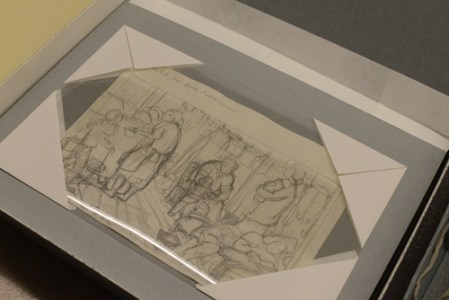
The National Constitution Center in Philadelphia is currently featuring the drawing All In One Room by Estelle Ishigo in their permanent exhibition The Story of We, the People. The drawing will be on display through November of 2014.
Estelle Peck Ishigo (1899-1990) is most well known as an artist who chronicled the experience at the Heart Mountain concentration camp.
Estelle Peck was born in Oakland in 1899 to parents of English, Dutch, French ancestry. Her family moved to Los Angeles and Estelle attended the Otis Art Institute, where she met Arthur Ishigo (1902-1957), a San Francisco-born Nisei who was working as a chauffeur for California Lieutenant Governor Robert Kenny. As anti-miscegenation laws at the time prohibited interracial couples from getting married, Peck and Ishigo took a trip across the border to Tijuana to be wed in 1928. Hoping for a career as an actor, Arthur worked as a janitor at Paramount Studios while Estelle worked as an art teacher. Shunned by her family, the couple lived among the Japanese American community.
![Estelle Ishigo (Gift of Mary Ruth Blackburn, Japanese American National Museum [2000.103.12])](https://i0.wp.com/media.discovernikkei.org/articles/4279/ishigo2.jpg?resize=269%2C215)
Throughout the war years, Estelle drew, sketched, and painted what she saw, providing a valuable document of life in the American concentration camps. “Strange as it may sound, in this desolate, lonely place I felt accepted for the first time in my life,” she later wrote of her time at Heart Mountain. She and her husband remained at Heart Mountain in order to record the last days of the camp until it was officially closed. The Ishigos were given $25 and put on a train to the West Coast. “I felt as if I were part of a defeated Indian tribe,” she remembered later.
In 1990, filmmaker Steven Okazaki made a documentary of Estelle Ishigo’s life titled Days of Waiting. Estelle passed away before seeing the film, which went on to win an Academy Award for Best Documentary Short.
Estelle Ishigo’s story and drawings comprise an important aspect of the permanent collection at the National Museum. The Estelle Ishigo Collection can be seen on the Museum’s website at: janm.org/collections/estelle-ishigo-collection
Learn more about Estelle Ishigo on our Discover Nikkei website >>
Submitted by Margaret Zachow Wetherbee, Collections Manager





